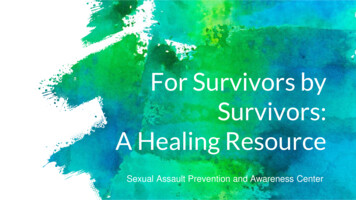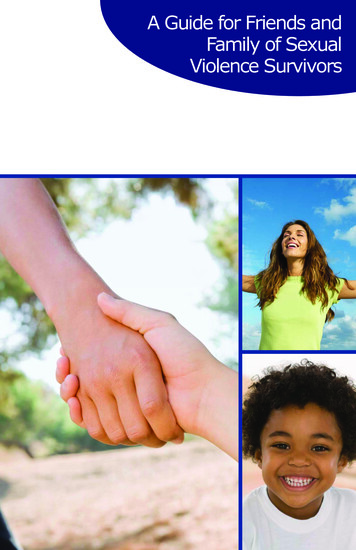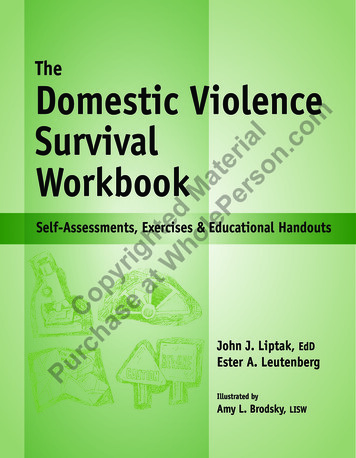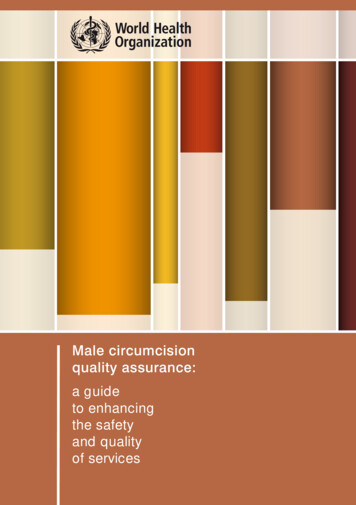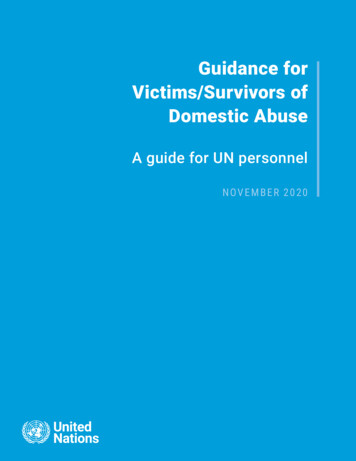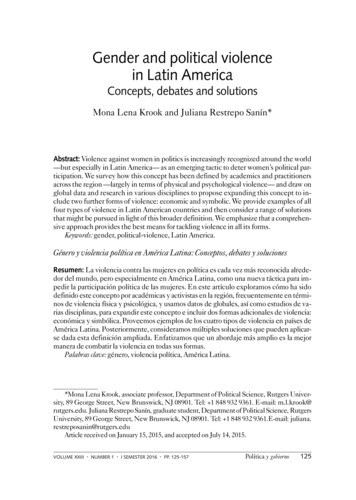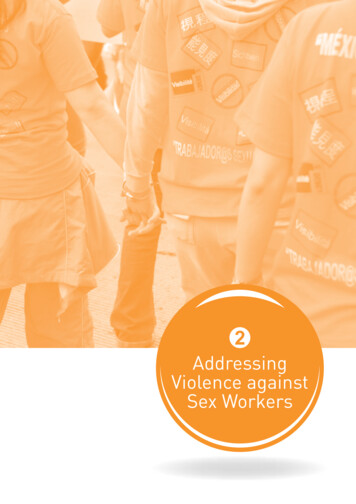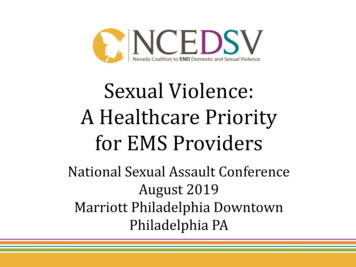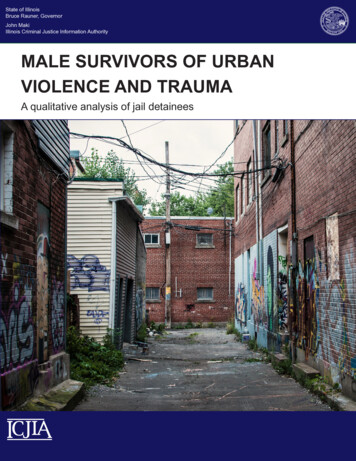
Transcription
State of IllinoisBruce Rauner, GovernorJohn MakiIllinois Criminal Justice Information AuthorityMALE SURVIVORS OF URBANVIOLENCE AND TRAUMAA qualitative analysis of jail detainees
MALE SURVIVORS OF URBAN VIOLENCE AND TRAUMAA qualitative analysis of jail detainees2015Prepared byJessica Reichert, Senior Research AnalystDawn Ruzich, Executive Director, Business Development, Gateway FoundationMichael Osher, Research InternThis evaluation was supported by Grant #s 2010-DJ-BX-0015 and 2009-DJ-BX-0023 awarded tothe Illinois Criminal Justice Information Authority by the Bureau of Justice Assistance, Office ofJustice Programs, U.S. Department of Justice. Points of view or opinions contained within thisdocument are those of the authors and do not necessarily represent the official position orpolicies of the Illinois Criminal Justice Information Authority or the U.S. Department of Justice.Suggested citation: Reichert, J., Ruzich, D., & Osher, M. (2015). Male survivors of urbanviolence and trauma: A qualitative analysis of jail detainees. Chicago, IL: Illinois CriminalJustice Information Authority.Illinois Criminal Justice Information Authority300 West Adams, Suite 200Chicago, Illinois 60606Phone: 312.793.8550Fax: 312.793.8422www.icjia.state.il.us
AcknowledgementsThe Authority wishes to thank the following individuals and agencies for providing assistanceand guidance for this project:Tom Dart, Cook County SheriffArthur Lurigio, Ph.D., Loyola University ChicagoThe agency would like to acknowledge the following Authority staff and former staff for theirassistance:Megan AlderdenJohn MakiCristin Monti EvansMark Myrent
Table of contentsKey findings . iIntroduction . 1Literature review . 2Methodology . 5Case studies . 7Case study #1: Victor . 7Case study #2: Robert . 9Case study #3: David . 11Case study #4: John . 12Case study #5: Anthony . 14Case study #6: Scott . 15Discussion . 17Implications for policy and practice . 19References . 23Appendix A: Interview questions and areas of discussion . 30Appendix B: Brief Jail Mental Health Screen (BJMHS) . 34Appendix C: PTSD Checklist-Civilian Version (PCL-C) . 35Appendix D: Life events checklist (LEC) . 36
Key findingsUrban violence is a major public health concern and at epidemic levels in some neighborhoods,directly impacting the mental health of its residents (Morris, n.d.). The rate of posttraumaticstress disorder (PTSD) among urban populations is estimated to be around 31 percent, higherthan the PTSD rate among returning Iraq war veterans of 17 percent (Donley et al., 2012; Hoge,Terhakopian, Castro, Messer, Engel, 2007). Research has found traumatic events in urbanneighborhoods can be associated with later criminal activity and substance use (Breslau,Chilcoat, Kessler, & Davis, 1999; Breslau, Davis, & Andreski, 1995; Scott, 2010; Widom &Maxfield, 2001). An estimated 6.3 million people in the United States are in need of PTSDtreatment, with higher proportions of sufferers concentrated in urban cities (Norris & Slone,2013).The cost of gun violence is estimated at 174 billion including loss of work productivity,medical care, pain and suffering, insurance, and criminal justice expenses (Miller, 2012).Researchers from the Illinois Criminal Justice Information Authority (Authority) and WestCareFoundation Illinois documented self-reported characteristics, experiences, and backgrounds ofmale survivors of urban violence. Researchers conducted in-depth interviews with six menreceiving substance abuse treatment while in custody at Cook County jail. All showed symptomsof mental health issues, trauma histories, and/or PTSD. The interviews focused on the men’s lifestories, traumas they experienced, and their coping mechanisms. Some may assume these menwere street savvy, immune to the continuous violence around them and to blame for theircircumstances, but the research revealed the men were profoundly negatively affected by theirexperiences in their homes and neighborhoods.All men said their neighborhoods were dangerous growing up and that crime and gunfire werecommon. All had been shot at and physically assaulted. Most had been robbed at gunpoint andstabbed. Most had witnessed someone’s murder or someone being seriously injured. Threeexperienced the sudden loss of a family member who was murdered; all thought at least oncethey would be killed or seriously injured.Trauma occurred early. By the age of five, half of those interviewed had already experienced atraumatic event. Domestic disruption and violence was common—three saw their fathersphysically abuse their mothers as children and all were either separated from, or abandoned by, aparent. Half of the interviewees were sexually abused or experienced unwanted sexual contact.Half had periods of homelessness. Two interviewees had been diagnosed with a mental illness,one had attempted suicide, and one had serious physical health issues.Their reactions to traumatic experiences varied. All said they used alcohol or drugs as a way tocope. Five began using drugs and/or alcohol during early adolescence. Four reported nightmaresand decreased intimacy or trust in others. Three suffered physical responses to stressful events,including anxiety, cold sweats, and difficulty concentrating. Two noticed impaired relationshipswith family or friends.i
Implications for policy and practiceFurther understanding and treatment are necessary to help individuals heal from trauma andimprove public health and criminal justice outcomes. Several implications for policy and practicewere identified during the course of this research.Offer treatment to male trauma survivorsNone of the interviewees received professional help or employed positive coping skills toaddress the trauma they had experienced. Screening for trauma and PTSD is needed to uncoverissues and develop a treatment plan. Service providers and criminal justice personnel can use atrauma-informed approach—understanding trauma signs and symptoms to support treatmentprotocols and limit re-traumatization (SAMHSA, 2015). Training for screening of trauma, aswell as trauma-based treatment is necessary (Adams, 2010). Best practices for trauma/PTSDtreatment include individual or group cognitive behavioral therapy and the treatment of cooccurring disorders when substance abuse is present (Beck & Coffey, 2005).Increase awareness of male survivors of urban traumaTrauma can affect anyone, but the men growing up in urban neighborhoods are more at-risk forexperiencing trauma and developing PTSD than those non-urban areas (Reese, et al., 2012).Public awareness of the trauma experienced by urban males, particularly among serviceproviders and criminal justice system practitioners, is needed. Urban men who seek medicaltreatment after a traumatic event are rarely referred to mental health services (Rich & Grey,2005).Conduct further research on urban traumaResearch is needed to better understand the prevalence of trauma among different populationsand those most at-risk, and identify strategies to help victims of urban violence (Rich & Grey,2005). Better awareness and understanding of the prevalence of PTSD in urban areas willsupport development of best practices to identify and treat individuals (Ouimette, Read, Wade, &Tirone, 2010).ii
IntroductionUrban violence is a major public health concern; in some American urban neighborhoodsviolence is at “epidemic levels” (Morris, n.d., p.3). Urban areas have higher crime rates andsuffer from a proliferation of gangs, guns and drugs (McCart, 2007). The prevalence of violencein urban communities has a direct impact on the mental health of its residents (Morris, n.d.).PTSD can occur following traumatic events such as physical or sexual assault, childhood abuse,war, natural or manmade disaster, act of terrorism, fire, sudden death of a loved one, chronic orterminal illness of a child, and plane or motor vehicle crash (Norris & Slone, 2007; Breslau,Davis, & Andreski, 1995). Research estimates the rate of PTSD among urban populations at 24to 31 percent (Breslau, Davis, Andreski, & Peterson, 1991; Donley, Habib, Jovanovic,Kamkwalala, Evces, Egan, Bradley, & Ressler, 2012). Rates of PTSD found in poor, high-riskpopulations in urban neighborhoods are as high or higher as PTSD noted in returning Iraq warveterans (17 percent) (Donley, Habib, Jovanovic, Kamkwalala, Evces, Egan, Bradley, & Ressler,2012).Little research is available on urban male victims of violence, trauma, and PTSD (Rich & Grey,2005) and even less research is available on those in criminal justice populations. Research hasshown the rate of PTSD is higher for criminal justice populations than for the general populationand a link exists between traumatic events and later criminal activity (Widom & Maxfield, 2001;Scott, 2010). Research in an urban city found a strong association between traumaexposure/PTSD and increased risk of involvement in the criminal justice system (Donley et al.,2012). In addition, research has shown a relationship between trauma, subsequent PTSD, andsubstance use (Breslau, Chilcoat, Kessler, & Davis, 1999; Breslau, Davis, & Andreski, 1995).This study examined the nature and extent of trauma among men held in custody in a large urbanjail. Researchers interviewed six men who first completed surveys which indicated they hadsome mental health-related issues, trauma, and/or PTSD. The qualitative interviews allowedresearchers to examine the particularity and complexity of their experiences. These case studiesshed light on the circumstances of, and types of, mental health issues and trauma experienced,providing a richer picture of mental health among male jail detainees.1
Literature reviewEach day, an average of 32 Americans die from gun violence and a disproportionate percentageof them are Black men in urban neighborhoods (Follman, Lurie, Lee, & West, 2015). Major U.S.cities have higher firearm homicides (Serafin, 2010). According to the Centers for DiseaseControl and Prevention, U.S. firearms caused 11,000 homicide deaths, or 3.5 per 100,000 people.Researchers estimated the total cost of gun violence at 174 billion including work lost, medicalcare, pain and suffering, criminal-justice expenses, and insurance (Miller, 2012). Howell &Abraham (2013) found hospital costs for firearm assault injuries were nearly 630 million.Urban violence is complex and due in part to inequality within communities’ social capital, longhistories of power struggles, and inadequate infrastructure (Dreier, 1996). For Chicago residents,and residents of other major U.S. cities, gun violence varies drastically for those living a fewstreets apart (Demby, 2014). Homicide rates in Chicago neighborhoods less than 10 miles apartvary. Jefferson Park on Chicago’s Northwest side, for instance, has a homicide rate of 3.1 per100,000 residents while West Garfield Park on the city’s West side has a rate of 64 per 100,000people (Papachristos, 2009).Gangs contribute to urban violence and an estimated 10 percent of youth in low incomeneighborhoods end up joining gangs (Vigil, 2003). In recent years, gang prevalence hasincreased with greater concentration in urban areas (National Gang Center, n.d.). Estimatesindicate there are 30,000 U.S. gangs and 850,000 gang members (National Gang Center, n.d.).Gangs are usually small groups of male youth who grow up together in similar cohorts (Vigil,2003). Gangs adopt values to obtain economic prosperity, use violence to control geographicalareas for drug commerce, and obtain strength through firearms (Police Executive ResearchForum, 1998). Gang members must prove their loyalty and gain respect in order to createpersonal and group identity, as well as protect themselves (Anderson, 1999). About 51 percent ofimprisoned youth recorded daily weapon carrying within the last 12 months (Vaughn, Howard,Harper-Chang, 2006).Research has shown that exposure to violence and trauma, such as witnessing or experiencingpersonal assaults or life-threatening events can have a significant impact on an individual’s levelof functioning, interpersonal relationships, and physical and mental health (Zatzick et al., 1997;Segman, Shalev, & Gelernter, 2007; Price & Stevens, 2009). Childhood traumas may lead toemotional and psychological effects on children such as sleep disorders, regression, and feelingsof self-blame and helplessness (Goodwin, 1998).Exposure to traumatic events may cause some to develop PTSD, an anxiety disorder found in theDiagnostics and Statistical Manual of Mental Disorders, Fourth Edition, Text Revision (DSMIV-TR). Symptoms often appear within three months after a traumatic event, but may be delayedmonths or even years (American Psychiatric Association, 2000). ).Figure 1depicts different populations that were PTSD-symptomatic (current not lifetime)—urbanpopulations have PTSD rates of 31 percent, higher than Iraq war veterans and male prisoners. Of2
a sample of patients at urban trauma center in Chicago, 42 percent screened positive for PTSD(Reese, et al., 2012).Figure 1PTSD-symptomatic by eneral popGeneral popwomenWar vet-IraqPrisoners-maleUrban popPrisoners-femaleData sources (from left to right): Kessler, Sonnega, Bromet, Huges, & Nelson, 1995; Resnick, Kilpatrick, Dansky,Saunders, & Best, 1993; Hoge, Terhakopian, Castro, Messer, & Engel, 2007; Gibson, Holt, Fondacaro, Tang,Powell, & Turbitt, 1999; Donley, Habib, Jovanovic, Kamkwalala, Evces, Egan, Bradley, & Ressler, 2012; Reichert& Bostwick, 2010.Research has shown those with PTSD have lower levels of everyday functioning and diminishedwell-being (Zatzick, et al., 1997). Individuals with PTSD have difficulty forming andmaintaining relationships and are five times as likely to be unemployed (Zatzick, et al., 1997;Jordan et al., 1992). In families where a spouse is suffering from PTSD, there are higher rates ofdivorce, family violence, emotional abuse, and marital discord (Jordan et al., 1992; Byrne &Riggs, 1996; Price & Stevens, 2009; Carlson & Ruzek, 2007; Nelson & Slone, 2007).Individuals diagnosed with PTSD have more difficulty with self-expression and communicationwhich leads to conflict within close relationships (Carroll, Rueger, Foy, & Donahoe, 1985).Furthermore, spouses of individuals suffering from PTSD are often forced to take on morechildcare and household responsibilities while coping with their partners’ PTSD symptoms(Nelson & Wright, 1996).Most PTSD sufferers have high levels of anger which may result in violent outbursts andaggression (Nelson & Wright, 1996). Individuals with PTSD have higher rates of criminalbehavior (Zatzick, et al., 1997). Traumatized urban residents may become involved with thecriminal justice system by aggressively acting out to obtain control of their lives, create personalidentity, and protect themselves, even carrying a weapon to restore feelings of safety (Anderson,1999; Lopez, 2014; Corbin, Purtle, Rich, Adams, Yee, & Bloom, 2013). Many may use illegal3
drugs to deal with trauma. Better engagement, assessment, and treatment will help individualswork through traumatic experiences and find direction within their lives (Ford & Blaustein,2013).4
MethodologyThis research study included a survey of more than 100 male jail detainees and in-depthinterviews of six men chosen from the larger sample. Study subjects were enrolled in theIntegrated Multistage Program of Assessment and Comprehensive Treatment (IMPACT), basedon a therapeutic community model that was modified for implementation in a secure jail setting.Administered by the WestCare Foundation, IMPACT provides intensive substance abusetreatment and other services to about 168 male detainees daily. Most of these detainees areawaiting court appearances to determine their case dispositions.Phase one: Survey of detaineesA total of 117 Cook County jail detainees participated in the survey. In order to gauge theprevalence of trauma and mental health issues, three well-known validated and standardizedtools were employed, including the Brief Jail Mental Health Screen (BJMHS), the PosttraumaticStress Disorder Checklist – Civilian Version (PCL-C), and the Life Events Checklist (LEC).These are provided in Appendices A, B, and C, respectively.The BJMHS accurately screens men with mental health illnesses in 73.5 percent of cases(Steadman et al., 2005).Researchers then administered the PCL-C, one of the most commonly used PTSD screeningtools (Elhai, Gray, Kashdan, & Franklin, 2005; Weathers, Litz, Herman, Huska, & Keane, 1993).This tool has been widely validated in studies across a wide range of populations (McDonald &Calhoun, 2010).Third, researchers administered the LEC, a reliable evaluation of trauma exposure that hasshown convergent validity with other instruments that assess exposure to traumatic events (Gray,Litz, Hsu & Lombardo, 2004).The first phase of the study found 21 percent of the sample met the criteria for probable PTSD(Ruzich, Reichert, & Lurigio, 2014).Phase two: Case studiesThe six men selected for interviews were chosen from the larger sample to learn from those withindicators of mental health issues, symptomatic for probable PTSD, and with a high number oftraumatic experiences in their life.5
Table 1Subject levels of scores on three measuresSubject*Brief JailMental Health Screen(BJMHS)PTSD ChecklistCivilian Version(PCL)Life ighHighHighLowLowLow*Pseudonyms usedResearchers conducted the qualitative interviews in 2012 in the Cook County jail. Each interviewtook one to two hours. Both researchers were course-certified on protection of human subjects.The study was approved by an Institutional Review Board to protect human subjects of research.All subjects received a consent form that informed about the research, the risk and benefits, andtheir rights as a participant of the study. All signed and consented to the research. Due to thesensitive nature of the interviews, all were given a referral sheet for various services to take withthem or they could talk to the jail counselor. Subjects shared personal accounts of theirexperiences and disclosed involvement with illegal and socially unacceptable activities, leadingthe researchers to believe they were being truthful during the interviews.The interviews were audio-recorded and transcribed. All were analyzed using NVivo qualitativesoftware.LimitationsThe qualitative interviews conducted in phase two allowed researchers to find out much moreabout a small number of individuals, but the information collected is not generalizable.Researchers conducted in-depth interviews with a small group of particular individuals. Thesample contained six men who grew up in the Chicago; housed in the Cook County jail andparticipating in the jail’s substance abuse program. All had indicators of mental health issues,traumatic events, and PTSD.6
Case studiesResearchers interviewed six individuals with varying levels of mental health issues and PTSD.Their surveys indicated all were in need of further mental health assessment, four weresymptomatic for probable PTSD, and three had experienced a great deal of trauma.The men participating in the qualitative interviews ranged in age from 19 to 48 years old andaveraged 30 years old. Three were Black, one was Middle Eastern, and two were Latino. Theyall grew up in Chicago.The following narratives are based on the interviews. Pseudonyms rather than actual names wereused.Case study #1: VictorBackgroundVictor was a 32 year old Hispanic male. He was born in Puerto Rico but moved back and forthbetween Puerto Rico and Chicago. Drugs, crime, and gunfire were common in the neighborhoodwhere he grew up. In fact, he described the home he grew up in as being about 15 feet away fromthe “dope spot.” He was raised by his mother and stepfather and neither were able to speak orhear. Also in the home were his two siblings and aunt. Victor’s step- father beat his mother andused crack cocaine. While growing up, he felt that only his aunt loved him unconditionally.When he was 12 years old, Victor joined a gang and started using cocaine and alcohol. Later, hisprimary drug of choice was heroin, which he injected daily. Despite his drug use and ganginvolvement, Victor finished high school and obtained an associate’s degree. His longest periodof employment was two-and-a-half years.Victor has had periods of homelessness. He had to rely on “crashing” at friend’s houses forshelter. The area he lived in prior to being jailed had a lot of gang activity, gunfire, crime, anddrugs.Victor has had two serious relationships but has never married. He has no children but reportedthat his girlfriend had a miscarriage. As an adult, he believes his aunt and his ex- girlfriend lovehim unconditionally.Victor attempted suicide twice, once at age 15 and again at 18. He has been diagnosed withdepression in the past. Victor also has significant medical problems. When he was 22 years old,he had a stroke and now has heart problems. He was recently diagnosed with Hepatitis C.Trauma historyVictor has an extensive trauma history that began when he was just a child. He has been a victimof abuse and assault, witnessed violence, and even experienced a natural disaster.7
Around age five, Victor was sexually abused by a male cousin. He also had unwanted sexualcontact when he was 15 years old with a 32-year-old woman.In addition to sexual abuse, Victor has been the victim of multiple violent acts. He was seriouslyphysically assaulted twice, robbed at gunpoint, and shot. He was also stabbed while in jail inPuerto Rico. Victor shared that he was almost kidnapped at gunpoint but his mother accosted thekidnappers and he was let go. Moreover, Victor lost a family member to violence. When he was12 years old, his oldest brother was killed.Victor handled two dead bodies and saw two people killed. He witnessed the first murder whenhe was about eight or nine years old.“The first one was -- I think this one traumatized me real bad. It was when I was a kid. Ithink I was like eight, nine years old. Me and my mom, my step-dad, my little brother andsister were coming from church. And it was nighttime. It was like 9 p.m. And we wereparking in the parking lot in the project and I saw these guys from the project justdragging this lady by her hair. And one of them had a handgun. The other had like, Ithink it was like a MP1 on him, you know, like before, like a little machine gun. And she'sscreaming and, you know, fighting with them. But they just dragging her And the guythat was holding the lady by her hair, he just put her down and boom, shot her in thehead. I can still see her head just going like this and just dropping down. They just walkaway, like they just killed a dog or, you know, something, like it was nothing for them. Soyeah. That was the first time that I see somebody killed.”Victor was in two serious car accidents; the first was when he was 15 and another when he was25 years old. He had his home broken into and experienced several hurricanes while living inPuerto Rico.Adaptation to traumaVictor scored high on the Brief Jail Mental Health Screen, PTSD Checklist, and Life EventsChecklist.Victor stated that after experiencing a traumatic event, his relationships with family or friendswas impaired and he noticed a decreased intimacy or trust in others. He also reported nightmaresand feeling edgy and anxious.“Like for some reason most of the time, no matter if I’m in a safe environment, I’m kindof like edgy, skeptical, you know, like sometimes I’m getting anxious for no reason. Likeright now, look. My hands start sweating really bad. Yeah. I lost a lot of sleep,nightmares, so bad that I remember when I was living with my girl, she used to wake meup and tell me that I used to say a lot of like crazy things in in my sleep.”Victor had never spoken openly about the traumas he has suffered. He used alcohol and drugs tocope and would sometimes turn to God.8
Case study #2: RobertBackgroundRobert was a 22-year-old Black male. He grew up in Chicago’s Woodlawn neighborhood.Robert described this neighborhood as being infested with drugs and gangs. He said that therewere often shootings on his block in his neighborhood. Nevertheless, he reported feelingrelatively safe growing up there. Robert has continued to live in this neighborhood.Robert was raised by his mother; he has three siblings and grew up with two of them. Whilegrowing up, his mother used 3 to 4 bags of heroin daily. Robert’s father left when he was threeand they had no further contact until Robert was 20 years old.At 12 years old, Robert joined a gang and tried alcohol and marijuana for the first time. Prior tohis current detainment, he used Xanax and alcohol daily and promethazine and codeine aboutevery three days.Robert had to repeat the 3rd grade and dropped out of school in the 11th grade. He reported beinga bully and having a lot of fights in school. His longest period of employment was less than onemonth.Robert has been in four serious relationships and has three children. He has always feltunconditional love from his mother and sister.Trauma historyWhile just 22 years old, Robert has already experienced a considerable amount of trauma. Thefollowing chronological account gives an example of its pervasiveness.Around age 4, Robert’s home was broken into and the intruders hung his niece out of a windowin front of him. He reported thinking that the men who did this were going to kill him and hisfamily.At age five, he saw his first dead body (one of three witnessed).At age six or seven, he saw a woman stab his mother in the head with a butcher knife. He fearedhe was going to be killed during this event.Around age seven, he saw his cousin get shot in the head and killed.9
Between the ages of seven and eight, he saw a woman gruesomely killed. He shared:“A car was chasing another car, shooting at them in the Woodlawn community. I wasyoung. And he was trying to get away from--and a man was going like probably like 70,80 miles an hour. And he had hit this old lady that was sitting in the park. She always sitin the park, read her book in Washington Park. And he had hit her and knocked half ofher face off her eyeball and stuff was hanging out.”When Robert was eight years old, he witnessed his older sister stab her husband 10 times. Hishome was broken into, and he was forced to touch his mother’s friend’s private parts or had histouched under threat of force.At age nine, he saw a man seriously beaten with a baseball bat, witnessed his mother’s boyfriendphysically assault her, and was in a serious car accident in which he and his mother hit abuilding.At age 17, Robert was robbed at gunpoint for the first time. He has been robbed at gunpoint threetimes. He also experienced unwanted sexual contact.At 18 years old, Robert was homeless for a period of time, his girlfriend had a miscarriage, andhe was shot in the back. He estimated he has been shot at approximately 30 times; three of thosetimes he thought he was going to die.“Then I almost got killed, and so you know, like I was outside one day, and somebody hadjumped out a car with a gun. So I had--I ran, but I slipped in the mud. And there’s justthe blessing from the Lord, ‘cause he was reaching over the car looking up. I’m seeingthe sparks from the gun. He’s just reaching--he’s reaching over the car and shooting atme. Blessing from the Lord .He missed all 12 shots.”“And then one time I was walking with my daughter, and somebody else had rode up on abike shooting at me. I was walking with my daughter.”“Another time when I was in the Woodlawn community, this boy was hanging out thewindow. He had one leg out the window. One- half his whole body was hanging out thewindow. He was on the passenger side of the car. He had a--he had a gun with a longclip on it, and he—he had shot up the block, and they bust a U-turn and came back andshot up the block again.”When he was 19 years old, his sister killed someone while driving drunk, and he went to jail forthe first time.At 21, Robert watched his friend get shot in the head.In addition, Robert shared that his youngest daughter was born with an enlarged heart and that hehas been the victim of domestic violence, including being stabbed and hit over the head
Urban violence is a major public health concern; in some American urban neighborhoods violence is at “epidemic levels” (Morris, n.d., p.3). Urban areas have higher crime rates and suffer from a proliferation of gangs,
